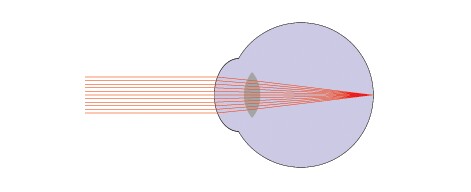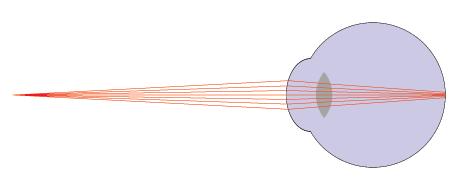The
Human Eye and Lens Systems
The human eye, like
many things in nature, is quite a remarkable thing. For many people, our
unaided eye can see objects that are both near and far is fairly good
detail, and can focus to provide us sharp images in times less than a
second. The major part of human vision is reliant on the lens in the
eye. The lens is the ellipsoidal disk that lies just behind the cornea.
Even though most of "light bending" is done by the air/cornea interface,
it is the lens that allows us to see the majority of the detail we see.
A
"Perfect" Eye
To begin our
discussion on human vision, we will start with a description of what the
"perfect" human eye should be. At "rest", a human eye should be able to
focus at an image that is coming in from "infinity". While this may
sound strange, all this means is that the light rays bouncing off an
object are moving in a direction that is almost parallel to one another.
In reality, this is actually true for anything that is more than five
meters away from our eyes. These parallel rays from an object should be
able to focus at the back of our eyes with a minimum of trouble.

In the above picture,
there is a scale "reproduction" of the eye. It turns out that the while
each of the many components of the eye contribute something, there are
two major portions. The first is actual air/cornea interface at the
front of the eye, and the second is the lens. Most of the liquid of the
eye is at a constant index of refraction, so that has been held constant
for the picture, and is represented by the blue. The floating grey disk
is the lens, and is arguably the most important part of human vision.
The lens can fine-tune our vision, so that we can see objects that are
closer than five meters away. The most noticeable thing that occurs for
objects in close is that the angles of the incoming ray change. If we
did nothing to our eyes, the rays would not focus, and we wouldn't be
able to see.

In order for us to see objects are close distance, there are tiny
muscles attached to the lens that stretch it out and thin out the lens
to reduce the focal length. In the first picture, you can see that the
rays do not focus to a complete point at the back of the eye; it seems
that the rays still have a little way to go before they focus together.
After the lens has been stretched out, then rays will focus at a much
shorter distance, and at some point should focus directly on the lens.
